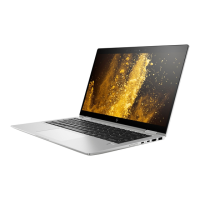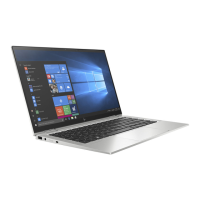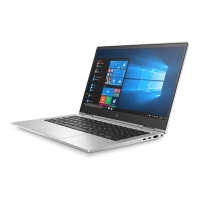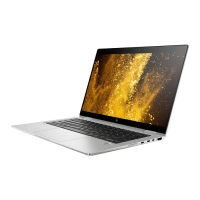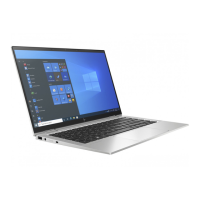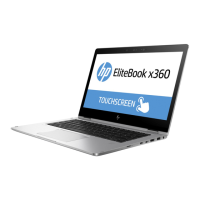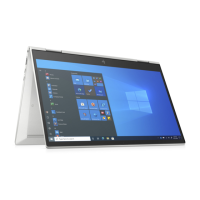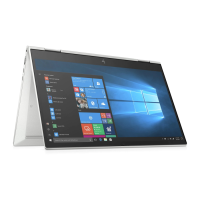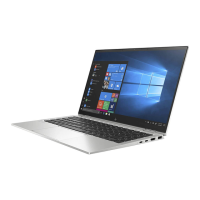
Do you have a question about the HP EliteBook x360 1040 G7 and is the answer not in the manual?
| Storage | Up to 2 TB PCIe NVMe SSD |
|---|---|
| Operating System | Windows 10 Pro |
| Processor | 10th Gen Intel Core i5/i7 |
| Display | 14" diagonal FHD (1920 x 1080) or UHD (3840 x 2160) touchscreen |
| RAM | Up to 32GB DDR4 |
| Graphics | Intel UHD Graphics |
| Ports | 2 Thunderbolt 3, 2 USB 3.1 Gen 1, 1 HDMI 2.0, 1 headphone/microphone combo |
| Wireless | Intel Wi-Fi 6 AX201 (2x2) and Bluetooth 5 Combo |
| Audio | Bang & Olufsen, 3 multi array microphone |
| Security | HP Sure View, Fingerprint reader, IR camera, TPM 2.0 |
Identifies components located on the right side of the computer.
Identifies components located on the left side of the computer.
Identifies components of the computer's display panel.
Details the components within the keyboard area of the computer.
Provides information and settings for the touchpad.
Describes the various indicator lights on the computer.
Identifies the power button, speakers, and fingerprint reader.
Details the special keys on the computer keyboard.
Explains function key combinations for specific products.
Identifies components located on the bottom of the computer.
Identifies components located on the top cover of the computer.
Identifies components located on the rear of the computer.
Details the location and purpose of various computer labels.
Provides instructions for inserting a nano SIM card.
Lists and describes the main computer components and their part numbers.
Lists and describes mass storage devices and their part numbers.
Lists and describes available cables and their part numbers.
Lists and describes various miscellaneous parts and their part numbers.
Lists the necessary tools for disassembly and reassembly procedures.
Provides important considerations for disassembly and assembly.
Explains the risks and prevention of electrostatic discharge (ESD).
Details precautions to prevent damage from static electricity.
Describes methods and equipment for personal grounding.
Provides precautions for grounding the work area.
Lists recommended materials and equipment for ESD prevention.
Offers guidelines for packaging and transporting equipment.
Instructions for removing and replacing computer components.
Steps to prepare the computer for disassembly.
Procedure for removing and replacing the bottom cover.
Procedure for removing and replacing the computer battery.
Procedure for removing and replacing the M.2 solid-state drive.
Procedure for removing and replacing the WWAN module.
Procedure for removing and replacing the connector board cable.
Procedure for removing and replacing the connector board.
Procedure for removing and replacing the display assembly.
Procedure for removing and replacing the computer speakers.
Procedure for removing and replacing the touchpad cable.
Procedure for removing and replacing the touchpad.
Procedure for removing and replacing the NFC module cable.
Procedure for removing and replacing the NFC module.
Procedure for removing and replacing the system board.
Procedure for removing and replacing the fan/heat sink assembly.
Procedure for removing and replacing the sensor board cable.
Procedure for removing and replacing the sensor board.
Procedure for removing and replacing the WWAN antenna.
Steps to access and start the computer's BIOS setup utility.
Information and steps for updating the system BIOS.
Methods to check the current BIOS version on the computer.
Prerequisites and precautions before updating the BIOS.
Instructions for downloading a BIOS update from HP.
Step-by-step guide for installing a downloaded BIOS update.
Methods for backing up data and creating recovery media.
Tools and methods for restoring the computer's system.
How to create a system restore point in Windows.
Describes different methods for system restoration.
Instructions for recovering the system using HP Recovery media.
Steps to modify the computer's boot order in BIOS.
Details on using HP Sure Recover for system restoration.
Guide to downloading the HP PC Hardware Diagnostics tool.
How to customize UEFI settings for remote diagnostics.
Provides general specifications for the computer.
Details the specifications for the 14.0-inch display.
Provides specifications for PCIe NVMe solid-state drives.
Provides specifications for SATA-3 solid-state drives.
Steps to restore nonvolatile memory to factory settings via BIOS.
Troubleshooting steps for nonvolatile memory.
Answers common questions regarding nonvolatile memory.
General power cord set requirements applicable globally.
Lists power cord requirements for specific geographic locations.
